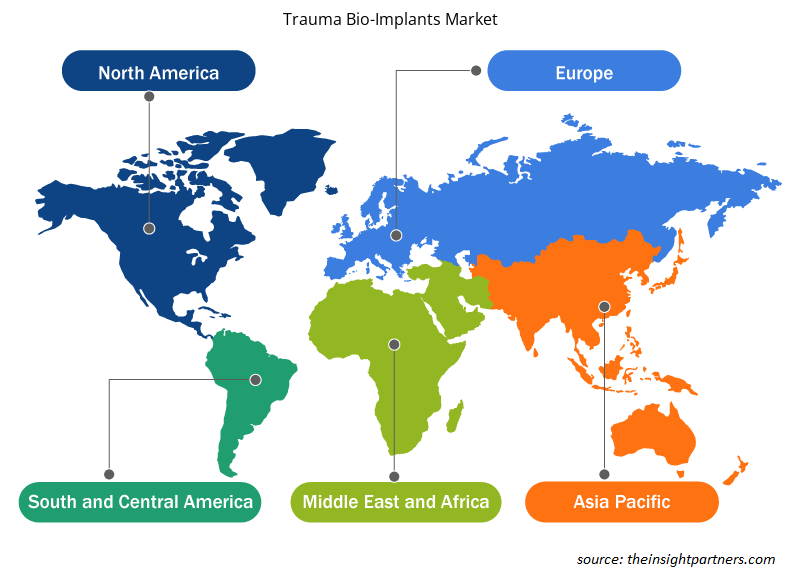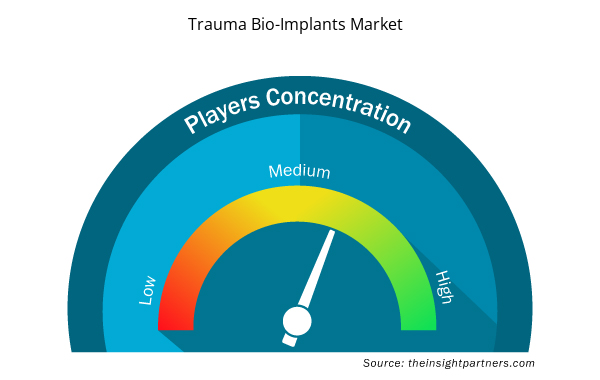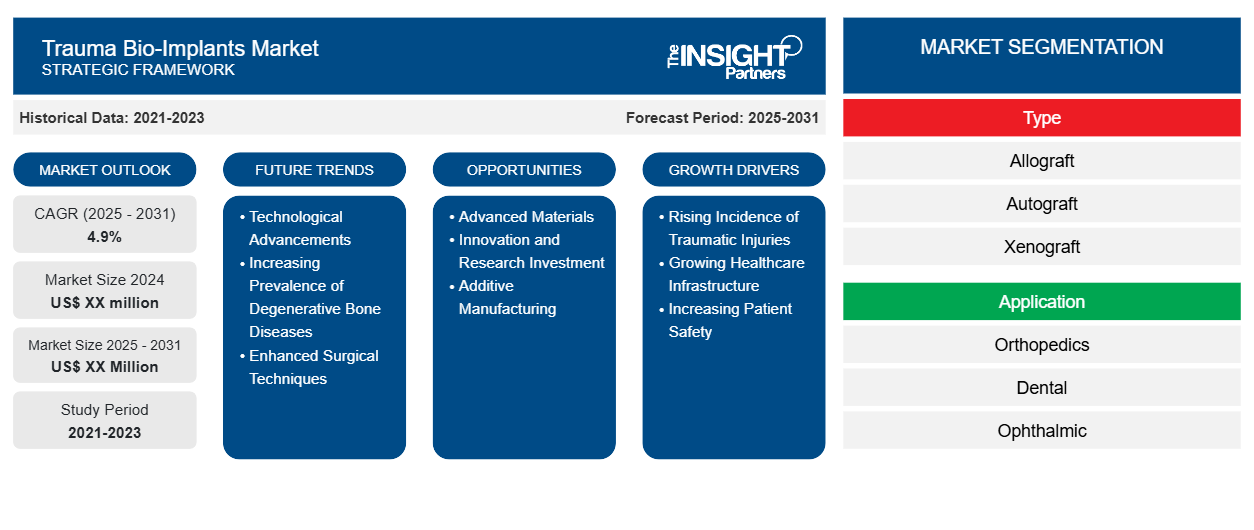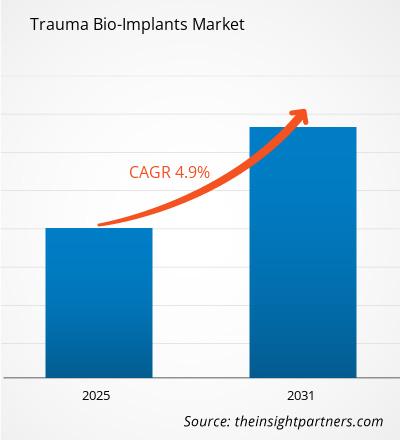Le marché des bio-implants traumatiques devrait enregistrer un TCAC de 4,9 % de 2024 à 2031, avec une taille de marché passant de XX millions USD en 2024 à XX millions USD d'ici 2031.
Le rapport est segmenté par marché des bio-implants traumatiques par type (allogreffe, autogreffe, xénogreffe) ; application (orthopédie, dentaire, ophtalmique, autres) et géographie (Amérique du Nord, Europe, Asie-Pacifique, Moyen-Orient et Afrique, et Amérique du Sud et centrale). L'analyse globale est ensuite décomposée au niveau régional et par principaux pays. Le rapport offre la valeur en USD pour l'analyse et les segments ci-dessus.
Objectif du rapport
Le rapport Trauma Bio-Implants Market de The Insight Partners vise à décrire le paysage actuel et la croissance future, les principaux facteurs moteurs, les défis et les opportunités. Cela fournira des informations à diverses parties prenantes commerciales, telles que :
- Fournisseurs/fabricants de technologie : pour comprendre l’évolution de la dynamique du marché et connaître les opportunités de croissance potentielles, leur permettant de prendre des décisions stratégiques éclairées.
- Investisseurs : Effectuer une analyse complète des tendances concernant le taux de croissance du marché, les projections financières du marché et les opportunités qui existent tout au long de la chaîne de valeur.
- Organismes de réglementation : Réglementer les politiques et surveiller les activités du marché dans le but de minimiser les abus, de préserver la confiance des investisseurs et de maintenir l’intégrité et la stabilité du marché.
Segmentation du marché des bio-implants traumatiques
Taper
- Allogreffe
- Autogreffe
- Xénogreffe
Application
- Orthopédie
- Dentaire
- Ophtalmique
- Autres
Personnalisez ce rapport en fonction de vos besoins
Vous bénéficierez d'une personnalisation gratuite de n'importe quel rapport, y compris de certaines parties de ce rapport, d'une analyse au niveau des pays, d'un pack de données Excel, ainsi que d'offres et de remises exceptionnelles pour les start-ups et les universités.
- Obtenez les principales tendances clés du marché de ce rapport.Cet échantillon GRATUIT comprendra une analyse de données, allant des tendances du marché aux estimations et prévisions.
Facteurs de croissance du marché des bio-implants traumatiques
- Incidence croissante des blessures traumatiques : Le besoin en bio-implants est considérablement accru par le nombre croissant de cas de traumatismes, qui incluent des fractures et des blessures liées à la pratique d'un sport ou à des accidents. Les blessures liées au sport et les accidents de la route sont de plus en plus fréquents à mesure que les gens du monde entier deviennent plus actifs, ce qui nécessite des options de traitement efficaces.
- Infrastructures de soins de santé en pleine croissance : le besoin de bio-implants sophistiqués pour les traumatismes est stimulé par l'évolution vers des méthodes chirurgicales moins invasives. Afin d'améliorer les délais de récupération et les résultats pour les patients, ces procédures nécessitent souvent des implants spécifiques qui peuvent être placés avec moins de perturbations pour les tissus environnants.
- Amélioration de la sécurité des patients : les bio-implants avancés pour traumatismes sont de plus en plus populaires en raison de la compréhension croissante des patients et des professionnels de la santé quant à leurs avantages. De plus en plus de patients recherchent une thérapie grâce aux campagnes de sensibilisation qui mettent en avant les résultats positifs de ces implants. Ce facteur a contribué à la croissance globale du marché au cours des dernières années et devrait poursuivre une tendance similaire au cours de la période de prévision.
Tendances futures du marché des bio-implants traumatiques
- Progrès technologiques : L'efficacité et la durabilité des implants traumatiques sont améliorées par les progrès continus des biomatériaux et de la conception des implants. Les progrès de l'impression 3D et des matériaux biocompatibles améliorent les performances et la personnalisation des implants, augmentant ainsi leur attractivité pour les patients et les chirurgiens. Ce facteur a contribué à la croissance globale du marché au cours des dernières années et devrait poursuivre une tendance similaire au cours de la période de prévision.
- Prévalence croissante des maladies dégénératives des os : l’ostéoporose et l’arthrose sont deux maladies en augmentation, en particulier chez les personnes âgées. Selon les projections de l’Organisation mondiale de la santé, il y aura 2 milliards de personnes de plus de 60 ans d’ici 2050, ce qui accroîtra le besoin de bio-implants pour traiter efficacement ces maladies dégénératives.
- Techniques chirurgicales améliorées : Le besoin de bio-implants sophistiqués pour les traumatismes est stimulé par l'évolution vers des méthodes chirurgicales moins invasives. Afin d'améliorer les délais de récupération et les résultats pour les patients, ces procédures nécessitent souvent des implants spécifiques qui peuvent être placés avec moins de perturbations pour les tissus environnants.
Opportunités de marché pour les bio-implants traumatiques
- Matériaux avancés : Des matériaux biocompatibles, notamment des alliages de titane, des céramiques et des polymères qui ressemblent à la structure osseuse naturelle, ont été développés grâce aux progrès de la recherche sur les matériaux. En résolvant les problèmes de rejet et les difficultés associées aux matériaux conventionnels, ces matériaux améliorent la durée de vie de l'implant et permettent une meilleure intégration dans le corps.
- Innovation et investissement dans la recherche : l’impression 3D permet de créer des implants personnalisés pour chaque patient et répondant à ses exigences anatomiques uniques. L’ajustement et la fonction sont améliorés par cette personnalisation, ce qui améliore les résultats chirurgicaux et la satisfaction du patient. De plus, elle facilite le prototypage rapide et les délais de fabrication des implants sont plus courts.
- Fabrication additive : Les progrès des techniques de fabrication additive garantissent une meilleure intégration osseuse et une meilleure stabilité de l'implant après la chirurgie. Grâce à cette technologie, des géométries complexes peuvent être créées, favorisant la formation osseuse autour de l'implant, augmentant ainsi son fonctionnement et sa stabilité globale.
Aperçu régional du marché des bio-implants pour traumatismes
Les tendances et facteurs régionaux influençant le marché des bio-implants pour traumatismes tout au long de la période de prévision ont été expliqués en détail par les analystes d’Insight Partners. Cette section traite également des segments et de la géographie du marché des bio-implants pour traumatismes en Amérique du Nord, en Europe, en Asie-Pacifique, au Moyen-Orient et en Afrique, ainsi qu’en Amérique du Sud et en Amérique centrale.

- Obtenez les données régionales spécifiques au marché des bio-implants traumatiques
Portée du rapport sur le marché des bio-implants pour traumatismes
| Attribut de rapport | Détails |
|---|---|
| Taille du marché en 2024 | XX millions de dollars américains |
| Taille du marché d'ici 2031 | XX millions de dollars américains |
| Taux de croissance annuel composé mondial (2025-2031) | 4,9% |
| Données historiques | 2021-2023 |
| Période de prévision | 2025-2031 |
| Segments couverts | Par type
|
| Régions et pays couverts | Amérique du Nord
|
| Leaders du marché et profils d'entreprises clés |
|
Densité des acteurs du marché des bio-implants pour traumatismes : comprendre son impact sur la dynamique commerciale
Le marché des bio-implants pour traumatismes connaît une croissance rapide, tirée par la demande croissante des utilisateurs finaux en raison de facteurs tels que l'évolution des préférences des consommateurs, les avancées technologiques et une plus grande sensibilisation aux avantages du produit. À mesure que la demande augmente, les entreprises élargissent leurs offres, innovent pour répondre aux besoins des consommateurs et capitalisent sur les tendances émergentes, ce qui alimente davantage la croissance du marché.
La densité des acteurs du marché fait référence à la répartition des entreprises ou des sociétés opérant sur un marché ou un secteur particulier. Elle indique le nombre de concurrents (acteurs du marché) présents sur un marché donné par rapport à sa taille ou à sa valeur marchande totale.
Les principales entreprises opérant sur le marché des bio-implants traumatiques sont :
- SOCIÉTÉ STRYKER
- BIOTRONIK SE ET CIE
- JOHNSON ET JOHNSON
- SMITH ET SON NEVEU
- SOCIÉTÉ SCIENTIFIQUE DE BOSTON
Avis de non-responsabilité : les sociétés répertoriées ci-dessus ne sont pas classées dans un ordre particulier.

- Obtenez un aperçu des principaux acteurs du marché des bio-implants pour traumatismes
Principaux arguments de vente
- Couverture complète : Le rapport couvre de manière exhaustive l’analyse des produits, des services, des types et des utilisateurs finaux du marché des bio-implants traumatiques, offrant un paysage holistique.
- Analyse d’experts : Le rapport est compilé sur la base d’une compréhension approfondie des experts et analystes du secteur.
- Informations à jour : Le rapport garantit la pertinence commerciale en raison de sa couverture des informations récentes et des tendances des données.
- Options de personnalisation : ce rapport peut être personnalisé pour répondre aux exigences spécifiques du client et s'adapter parfaitement aux stratégies commerciales.
Le rapport de recherche sur le marché des bio-implants pour traumatismes peut donc aider à ouvrir la voie au décodage et à la compréhension du scénario de l’industrie et des perspectives de croissance. Bien qu’il puisse y avoir quelques préoccupations valables, les avantages globaux de ce rapport ont tendance à l’emporter sur les inconvénients.
- Analyse historique (2 ans), année de base, prévision (7 ans) avec TCAC
- Analyse PEST et SWO
- Taille du marché Valeur / Volume - Mondial, Régional, Pays
- Industrie et paysage concurrentiel
- Ensemble de données Excel



Report Coverage
Revenue forecast, Company Analysis, Industry landscape, Growth factors, and Trends

Segment Covered
This text is related
to segments covered.

Regional Scope
North America, Europe, Asia Pacific, Middle East & Africa, South & Central America

Country Scope
This text is related
to country scope.
Questions fréquemment posées
Budgetary Constraints
Europe region is expected to witness a high growth rate in terms of CAGR after Asia Pacific region during the forecast period
The Trauma Bio-Implants Market is estimated to witness a CAGR of 4.9% from 2023 to 2031
Rising Incidence of Traumatic Injuries
Asia Pacific region is expected to witness the highest growth during the forecast period
Trends and growth analysis reports related to Life Sciences : READ MORE..
1. STRYKER CORPORATION
2. BIOTRONIK SE AND CO
3. JOHNSON AND JOHNSON
4. SMITH AND NEPHEW
5. BOSTON SCIENTIFIC CORPORATION
6. ABBOTT LABORATORIES
7. MIMEDX GROUP
8. COOK GROUP
9. LIFENET HEALTH
10. BAUSCH AND LOMB INCORPORATED
The Insight Partners performs research in 4 major stages: Data Collection & Secondary Research, Primary Research, Data Analysis and Data Triangulation & Final Review.
- Data Collection and Secondary Research:
As a market research and consulting firm operating from a decade, we have published and advised several client across the globe. First step for any study will start with an assessment of currently available data and insights from existing reports. Further, historical and current market information is collected from Investor Presentations, Annual Reports, SEC Filings, etc., and other information related to company’s performance and market positioning are gathered from Paid Databases (Factiva, Hoovers, and Reuters) and various other publications available in public domain.
Several associations trade associates, technical forums, institutes, societies and organization are accessed to gain technical as well as market related insights through their publications such as research papers, blogs and press releases related to the studies are referred to get cues about the market. Further, white papers, journals, magazines, and other news articles published in last 3 years are scrutinized and analyzed to understand the current market trends.
- Primary Research:
The primarily interview analysis comprise of data obtained from industry participants interview and answers to survey questions gathered by in-house primary team.
For primary research, interviews are conducted with industry experts/CEOs/Marketing Managers/VPs/Subject Matter Experts from both demand and supply side to get a 360-degree view of the market. The primary team conducts several interviews based on the complexity of the markets to understand the various market trends and dynamics which makes research more credible and precise.
A typical research interview fulfils the following functions:
- Provides first-hand information on the market size, market trends, growth trends, competitive landscape, and outlook
- Validates and strengthens in-house secondary research findings
- Develops the analysis team’s expertise and market understanding
Primary research involves email interactions and telephone interviews for each market, category, segment, and sub-segment across geographies. The participants who typically take part in such a process include, but are not limited to:
- Industry participants: VPs, business development managers, market intelligence managers and national sales managers
- Outside experts: Valuation experts, research analysts and key opinion leaders specializing in the electronics and semiconductor industry.
Below is the breakup of our primary respondents by company, designation, and region:

Once we receive the confirmation from primary research sources or primary respondents, we finalize the base year market estimation and forecast the data as per the macroeconomic and microeconomic factors assessed during data collection.
- Data Analysis:
Once data is validated through both secondary as well as primary respondents, we finalize the market estimations by hypothesis formulation and factor analysis at regional and country level.
- Macro-Economic Factor Analysis:
We analyse macroeconomic indicators such the gross domestic product (GDP), increase in the demand for goods and services across industries, technological advancement, regional economic growth, governmental policies, the influence of COVID-19, PEST analysis, and other aspects. This analysis aids in setting benchmarks for various nations/regions and approximating market splits. Additionally, the general trend of the aforementioned components aid in determining the market's development possibilities.
- Country Level Data:
Various factors that are especially aligned to the country are taken into account to determine the market size for a certain area and country, including the presence of vendors, such as headquarters and offices, the country's GDP, demand patterns, and industry growth. To comprehend the market dynamics for the nation, a number of growth variables, inhibitors, application areas, and current market trends are researched. The aforementioned elements aid in determining the country's overall market's growth potential.
- Company Profile:
The “Table of Contents” is formulated by listing and analyzing more than 25 - 30 companies operating in the market ecosystem across geographies. However, we profile only 10 companies as a standard practice in our syndicate reports. These 10 companies comprise leading, emerging, and regional players. Nonetheless, our analysis is not restricted to the 10 listed companies, we also analyze other companies present in the market to develop a holistic view and understand the prevailing trends. The “Company Profiles” section in the report covers key facts, business description, products & services, financial information, SWOT analysis, and key developments. The financial information presented is extracted from the annual reports and official documents of the publicly listed companies. Upon collecting the information for the sections of respective companies, we verify them via various primary sources and then compile the data in respective company profiles. The company level information helps us in deriving the base number as well as in forecasting the market size.
- Developing Base Number:
Aggregation of sales statistics (2020-2022) and macro-economic factor, and other secondary and primary research insights are utilized to arrive at base number and related market shares for 2022. The data gaps are identified in this step and relevant market data is analyzed, collected from paid primary interviews or databases. On finalizing the base year market size, forecasts are developed on the basis of macro-economic, industry and market growth factors and company level analysis.
- Data Triangulation and Final Review:
The market findings and base year market size calculations are validated from supply as well as demand side. Demand side validations are based on macro-economic factor analysis and benchmarks for respective regions and countries. In case of supply side validations, revenues of major companies are estimated (in case not available) based on industry benchmark, approximate number of employees, product portfolio, and primary interviews revenues are gathered. Further revenue from target product/service segment is assessed to avoid overshooting of market statistics. In case of heavy deviations between supply and demand side values, all thes steps are repeated to achieve synchronization.
We follow an iterative model, wherein we share our research findings with Subject Matter Experts (SME’s) and Key Opinion Leaders (KOLs) until consensus view of the market is not formulated – this model negates any drastic deviation in the opinions of experts. Only validated and universally acceptable research findings are quoted in our reports.
We have important check points that we use to validate our research findings – which we call – data triangulation, where we validate the information, we generate from secondary sources with primary interviews and then we re-validate with our internal data bases and Subject matter experts. This comprehensive model enables us to deliver high quality, reliable data in shortest possible time.


 Obtenez un échantillon gratuit pour ce rapport
Obtenez un échantillon gratuit pour ce rapport